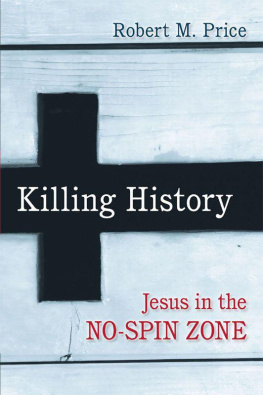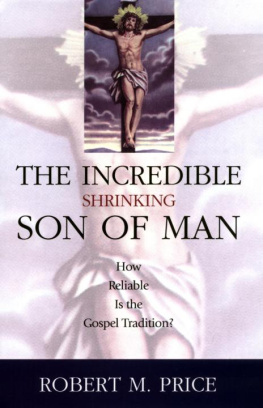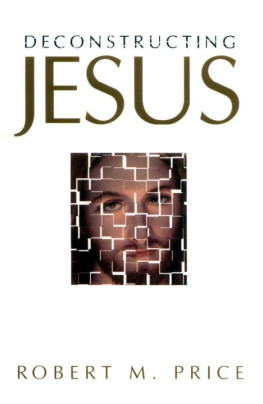ALSO BY ROBERT M. PRICE
Deconstructing Jesus
Incredible Shrinking Son of Man: How Reliable Is the Gospel Tradition?
The Empty Tomb: Jesus Beyond the Grave
The Da Vinci Fraud: Why the Truth Is Stranger than Fiction
The Reason-Driven Life: What Am I Here on Earth For?
The Paperback Apocalypse: How the Christian Church Was Left Behind
Top Secret: The Truth behind Today's Pop Mysticism
Inerrant the Wind: The Evangelical Crisis in Biblical Authority

Published 2014 by Prometheus Books
Killing History: Jesus in the No-Spin Zone . Copyright 2014 by Robert M. Price. All rights reserved. No part of this publication may be reproduced, stored in a retrieval system, or transmitted in any form or by any means, digital, electronic, mechanical, photocopying, recording, or otherwise, or conveyed via the Internet or a website without prior written permission of the publisher, except in the case of brief quotations embodied in critical articles and reviews.
Prometheus Books recognizes the following registered trademarks, trademarks, and service marks mentioned within the text: Avon, Cracker Jack, Facebook, iPhone, Nick at Nite, Rosetta Stone, Twitter
Cover image Media Bakery
Cover design by Grace M. Conti-Zilsberger
Inquiries should be addressed to
Prometheus Books
59 John Glenn Drive
Amherst, New York 14228
VOICE: 7166910133
FAX: 7166910137
WWW.PROMETHEUSBOOKS.COM
18 17 16 15 14 5 4 3 2 1
The Library of Congress has cataloged the printed edition as follows:
Price, Robert M., 1954-
Killing history : Jesus in the no-spin zone / by Robert M. Price.
pages cm
Includes bibliographical references and index.
ISBN 978-1-61614-966-6 (pbk.) ISBN 978-1-61614-967-3 (ebook)
1. Jesus ChristHistoricity. 2. OReilly, Bill. Killing Jesus. I. Title.
BT303.2.P753 2014
232.96dc23
2014012135
Printed in the United States of America


Bill OReilly is a phenomenon. He is the host of the top-rated The OReilly Factor and the coauthor of a number of bestselling historical books, notably Killing Lincoln and Killing Kennedy . To these he has recently added Killing Jesus: A History , written with Martin Dugard. I must confess to being a frequent viewer of The Factor . I enjoy Bill OReilly's humor, and I usually agree with his social and political opinions (though on some issues he is not quite conservative enough to suit me). I want you to be aware of this at the outset, because I want it to be clear I am not one of the man's detractors who look for any opportunity to take him down. This book, a rejoinder to Killing Jesus , I felt compelled to write by my professional conscience as a New Testament scholar. It is evident to me that Bill OReilly and Martin Dugard are writing way, way out of their fields of expertise and that they simply do not understand either the principles of critical historiography or the difference between a historical and a religious treatment of a topic.
Killing Jesus attempts to apply the same principles of journalistic research that worked well enough in OReilly and Dugard's books on the Lincoln and Kennedy assassinations. But it does not work. I hope to show (as much as I regret having to) that the task of reconstructing the events connected with a figure like Jesus Christ, the deity of the Christian faith, and that of writing about modern political figures, is as different as the heavens are from the earth. And Killing Jesus depends essentially upon ignoring that difference. I should estimate that reporting the historical truth about Jesus falls somewhere between documenting the facts about Robin Hood and Superman. It is just not the same thing at all. Another thing I aim to demonstrate is that to treat Jesus as one treats Abe Lincoln tends to make nonsense of the gospels, our main source concerning Jesus. If one loves the gospel accounts and wants to appreciate them by the standards by which they were written, one does not come out where OReilly and Dugard do. One does not even begin where they begin. If there is any parallel at all between writing about JFK and writing about Jesus, we might have to compare using the gospels for a blow-by-blow account to drawing up Killing Kennedy from the mass of conspiracy theories entertained by Dale Gribble. In both cases we are dealing with a genre very different from straight history.
Any biographer of Kennedy or of Lincoln must familiarize himself with the earliest available source material (though the gospels are not nearly so early or reliable as our authors believe) and then do a comprehensive study of previous work in the field. One would, for instance, weigh and compare the very different portraits of Honest Abe drawn by Carl Sandburg and C. A. Tripp, who claimed to have outed Lincoln as a homosexual. It is important not to disregard the history of scholarship lest one, impatient to reinvent the wheel, wind up producing a wheel greatly inferior to those already available. There is no sign whatsoever that the authors of Killing Jesus have even begun to do their homework here. In the end notes, true, we find a number of book recommendations, but it is revealing that virtually every one of the New Testament and Jesus books mentioned are the work of evangelical/fundamentalist spin doctors dedicated to defending the proposition that the gospels are entirely accurate, miracles and all. We are not in the No-Spin Zone anymore. And it is not that OReilly and Dugard actually discuss the arguments of these authors. It seems, rather, that OReilly and his collaborator have simply cited these apologists for the faith as a license to treat the gospels as inerrant scripture.
OReilly has many times contended that Killing Jesus sticks to the facts and stops short of promoting religious doctrine. Please tell me how a purely historical work time and again asserts as simple fact that Jesus fulfilled Old Testament predictions. It is not enough to refrain from calling Jesus Christ. That does not make the book impartial history. The entire treatment of the Bible bears witness that OReilly and Dugard are approaching it as committed religious believers. Both are proud Roman Catholics. So was the late, great New Testament scholar Raymond E. Brown (whose magisterial work The Death of the Messiah , thankfully, our authors recommend in the end notes), but Father Brown knew the difference between historical research and proof-texting, between writing a scholarly work and writing a narrative novel with a few pedantic digressions thrown in. Raymond E. Brown, Joseph A. Fitzmyer, John Meier, Hans Kng, Edward Schillebeeckx, Thomas L. Brodie, Herman Hendrickx, Jon Sobrino, all are Roman Catholicsand not one of them would ever be caught with his name on a book like this one.
Killing Jesus has nothing to do with Life of Jesus studies. It is in fact almost a twin to Mel Gibson's oh-so-authentic 2004 film The Passion of the Christ . Both are exhibitions of popular piety aimed at reinforcing believers faith and stilling their doubts by providing a real-seeming illusion about the myths and legends of the gospels. Their function is not dissimilar to that of the numerous End Times movies and novels like Left Behind , Image of the Beast , and A Distant Thunder . Those fictions, whether on screen or page (and Killing Jesus is already heading for the screen), help buttress faith in the ever-receding, always deferred Second Coming of Christ by depicting it in narrative form before the eyes of those who would really like to see the Rapture, the Great Tribulation, and so on, occurring on the evening news. They don't. They can't. So End Times fiction is the next best thing, a game of pretend. And that is just the role of The Passion of the Christ and Killing Jesus . The familiar Sunday school tales are dressed up in pseudo-documentary form to make the Christian reader feel confident that the legends are historical reports, not legends at all. It is all a trick, though Gibson, OReilly, and Dugard are presumably tricking themselves as well.



















